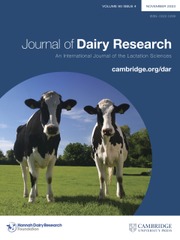No CrossRef data available.
Article contents
Comparing rumination activity using the Nedap® rumination sensor against analysis of video recordings in pre-weaned dairy calves
Published online by Cambridge University Press: 29 August 2025
Abstract
This Research Communication describes a pilot study to validate a rumination sensor for pre-weaned dairy calves. There is increasing interest in precision livestock farming (PLF) tools to capture behaviours and health parameters in farm animals. However, much of the research has focused on devices suitable for adult animals, and few devices have been validated for young animals. The aim of our pilot study was to validate the rumination estimates from Nedap rumination sensors® (NRS) when worn by dairy calves less than 2 months of age. Eight Norwegian Red dairy calves were raised in a cow-directed cow-calf-contact system such that cows could visit their calves through a smartgate. At 21 days of age, an NRS was secured around the neck of each calf, to record the amount of time spent ruminating/24 h. Cameras were placed above the calf areas to record the calves for the entirety of the study. When the calves were 28 and 58 d old, four trained observers recorded rumination behaviour 24 h/d from the video recordings. The video data and the NRS data recorded over 24 h on the same days were compared using the Wilcoxon signed-rank test, the Spearman’s rank correlation and concordance correlation. NRS estimates were moderately correlated with calf rumination behaviour as measured from video observations but underestimated the duration of time spent ruminating by approximately 76%. Perhaps the calves’ rumination movements were too subtle for the NRS to detect, or the NRS needed a different placement on the calf’s small neck to record the behaviour accurately. Although automatic recordings from PLF tools may save observation time, our results indicate that the NRS may not yet accurately detect rumination behaviour in pre-weaned dairy calves.
Information
- Type
- Research Communication
- Information
- Copyright
- © The Author(s), 2025. Published by Cambridge University Press on behalf of Hannah Dairy Research Foundation.

